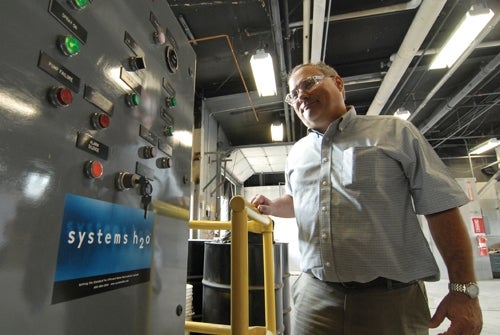The work that goes on at the various business units on the Saint-Gobain Worcester campus involves the application of heat — lots of it — which means gallons, nearly 123 million gallons per year, of water must be used to cool down equipment.
But over the past two years, Saint-Gobain has made a concerted effort to reduce its dependency upon well water and has achieved a remarkable 79 percent reduction in its annual usage of water.
In 2008, Saint-Gobain used 25.5 million gallons of water, down from 122.9 million gallons the previous year. It is a yearly reduction in usage that actually would have been greater had the new changes been in place for the entirety of 2008, said Joseph Dufresne, senior environmental engineer at Saint-Gobain.
Team Effort
“We are proud of that reduction,” said Dufresne, who predicts greater preservation of resources in the coming years.
Part of Dufresne’s job is to deal with various regulatory agencies, such as the state Department of Environmental Protection and the federal Environmental Protection Agency.
“We feel it is a big achievement and will have a positive impact on the environment …We are doing something positive in that we are preserving a resource and we are discharging less water (into the environment).”
And Saint-Gobain is not done yet. The company hopes to further reduce its use of well water, projecting that by the end of this year its annual well water use will be in the range of 20 million gallons per year.
Dufresne is hopeful that by 2010, the company’s annual usage will drop by yet another 5 million gallons.
The nearly 80 percent reduction in water use for 2008 is the result of the effort of the several business units that operate on the Saint-Gobain Worcester campus, said Dufresne.
The effort began about two years ago, when Saint-Gobain decided to get certified by the ISO 14001 Environmental Management System, which sets an international management standard for manufacturers.
The goal of the ISO 14001 is to help manufacturers better understand their impact on the environment, Dufresne said. In 2008, Saint-Gobain underwent an audit and was determined to be in compliance with the ISO 14001 standards.
As part of the certification process, Saint-Gobain determined that it used quite a bit of well water to cool the heat produced by its manufacturing processes.
The old technology required the use of well water to cool equipment and then discharged that water into Weasel Brook, which runs through Saint-Gobain property.
That technology created two problems: the use of millions and millions of gallons of well water and the discharge of the heated water into the environment, explained Dufresne.
Groundwater is an important resource that is better to preserve than to use, said Dufresne, so it made sense to look into ways to limit Saint-Gobain’s use of that water.
“That groundwater is now available for some other use in the future,” he said.
As for the discharge of heated water into Weasel Brook, Saint-Gobain has a permit that allows that discharge, but the better thing to do is send as little as possible of that heated water into the environment, said Dufresne.
Keeping Cool
“The less warm water you have going into a brook, the better off you are,” he said, explaining that heated water can decrease the oxygen content of water and can change the kind of species that live in the water.
In short, heated water can have a negative impact on an ecosystem, and that is the reason its discharge is regulated.
Saint-Gobain’s permit allows it to discharge water that is no greater in temperature than 83 degrees, according to Dufresne.
In an effort to lessen Saint-Gobain’s environmental impact, all of the businesses undertook separate projects to reduce their dependency on ground water and to thereby reduce the amount of water discharged each year.
For example, the refractory business had air compressors that were water cooled, with the heated water then being discharged into the brook.
Today, that business has air-cooled compressors, with the heat being blown out of the building. Some of that heat is then recycled to heat an outbuilding, said Dufresne. This change resulted in the reduction in use of 36 million gallons of water per year.
The abrasives business achieved a 15 million gallon-per-year reduction by installing a heat exchanger, which Dufresne described as “a large radiator.”
Heated water is pumped out to the giant radiator and “the heat is given up to the air,” he said.
By 2010, Saint-Gobain hopes to be using less than 20 million gallons of water a year, which would represent an 85 to 90 percent reduction from the 123 million gallons per year it once used.
Ellen O’Connor is a freelance writer based in Worcester. She can be reached at eokie@charter.net.

